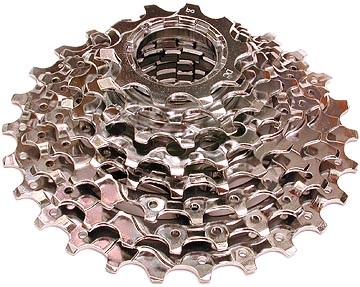Das Shimano Capreo System
Kleine Laufräder für Fahrräder haben echten Mehrwert für bestimmte Anwendungsfälle. Hauptsächliche Fälle sind Falträder und kompakte Liegeräder. Die Größe der Laufräder zu reduzieren, erlaubt die Gesamtgröße eines Fahrrads zu reduzieren. Im Falle von Liegerädern bedeutet das, dass man den Sitz niedriger platzieren kann.
Durch die Verbesserung von Reifen ist der erhöhte Rollwiderstand kleinerer Reifen kein großes Thema mehr. Weiterhin ist es aber immer noch ein Problem, vernünftig hohe Gänge mit kleinen Laufrädern zu erreichen.
Die Gangabstufungen normaler kettenschaltungsgetriebener Laufräder ist proportional zum Laufraddurchmesser. Das heißt, wenn man kleinere Laufräder bei gleichen Ritzelgrößen wie bei normal großen Laufrädern verwendet, werden alle Gänge automatisch kleiner.
Kleine Gänge sind normalerweise kein Problem. Durch den Einsatz von sehr engen Ritzelpaketen aus dem Renneinsatz, kann man kleine Gänge vergrößern, wenn man nicht unbedingt super kleine Gänge wünscht.
Große Gänge mit kleinen Laufrädern
Am oberen Ende wird es jedoch schwierig mit kleinen Laufrädern. Es gibt nur drei Möglichkeiten einen vernünftigen hohen Gang mit kleinen Laufrädern zu erzielen.
Größere Kettenblätter
Wenn man ein 406 mm (20 Zoll) Laufrad hat, muss man ein Kettenblatt mit 69 Zähnen verbauen, um ein Äquivalent zum 52er Kettenblatt beim 622 mm (28 Zoll) Laufrad zu haben.
Wenn man ein 349 mm (16 Zoll) Laufrad hat, muss man ein Kettenblatt mit 86 Zähnen verbauen, um ein Äquivalent zum 52er Kettenblatt beim 622 mm (28 Zoll) Laufrad zu haben!
Selbst falls man ein solch großes Kettenblatt zu einem erschwinglichen Preis finden sollte, wird man doch keinen Umwerfer finden, der auf diese Größe schalten kann.
Nabenschaltung
- A planetary internal gear system, either built into the rear hub or the bottom bracket can be used to to supplement the derailer gearing, and give a decent high gear. These systems are expensive, heavy and lose efficiency to friction, so they're not universally popular.
Kleinere Ritzel
- This is potentially the simplest and least expensive way to go, but until recently this was not an option. The smallest sprockets generally available have been 11 teeth, not enough to give a serious high gear with normal-sized chainrings.
- Special, very expensive freewheels with 9-tooth sprockets have been available for Moulton bikes, but Moulton has been reluctant to market them to owners of other brands of bikes.
- Enter the Shimano Capreo system! This is Shimano's first group intended specifically for small wheel bikes. The Capreo system includes:
- FH-700 Freehub.
- Special 9-speed Freehub, 135 mm spacing, 24, 32 or 36 holes.
- CS-HG70-s Cassette
- 9-10-11-13-15-17-20-23-26 tooth sprockets.
- RD-700 Rear derailer.
There are other items included in the Capreo "group" including brakes, rear derailer, crank, shifter, but there is nothing all that special about those. Even the Capreo rear derailer is not necessary to the system, but the Capreo cassette and Capreo Freehub must be used together.
The Capreo cassette won't fit any other hub. The Capreo hub won't accept any other cassette.
Die Capreo Kassette
The 5 largest sprockets of the Capreo cassette are standard Shimano cassette sprockets: 15, 17, 20, 23 and 26 teeth. They are individual sprockets, not linked by a spider, but the 4 largest (17-26) are held together by rivets. There is, however nothing preventing an adventurous user from grinding off the heads of the rivets and customizing the bottom end of the gearing.
The 4 smallest sprockets, 9, 10, 11 and 13 teeth are all special.
- The 13 tooth sprocket engages the main splines of the Freehub, but the outside of it is recessed to allow the special 11 to reach the splines. This particular 13 is also used on a couple of other 9-speed models.
- The 11 tooth has male splines that engage the Capreo Freehub body, and female splines on the outside to engage the 10.
- The 10 tooth has male splines that engage the special 11, and female splines on the outside to engage the 9.
- The 9 tooth has male splines that engage the special 10 and there is a very small female threaded lockring that holds everything together.
Die Capreo Freilaufnabe
The Capreo Freehub has a special body designed to accommodate then smaller diameter of the 9 and 10 tooth sprockets. Otherwise, it appears pretty much similar to other Shimano Freehubs.
Instead of using the male threaded lockring common to other Hyperglide cassettes, the Capreo uses a much smaller female threaded lockring, using the same 22 x 1 mm thread as common crank extractors.
It comes set up for 135 mm spacing, but the left side of the axle has two removable spacing washers, one of which is 4 mm and the other 8 mm thick. By removing spacers and trimming the axle, this hub could easily be adapted to other spacings, though this would result in a wheel with more dish.
Quelle
Dieser Artikel basiert auf dem Artikel The Shimano Capreo System von der Website Sheldon Browns. Originalautor des Artikels ist Sheldon Brown.
<img size=1x1>http://vg04.met.vgwort.de/na/198c3254a88b4122acd21aeeada9e2d7</img>
